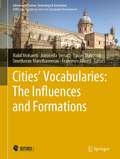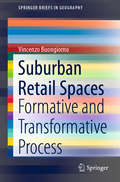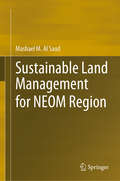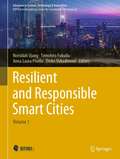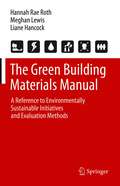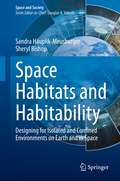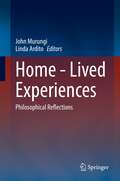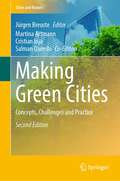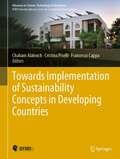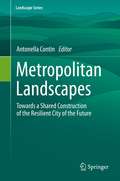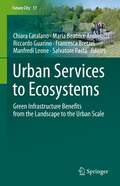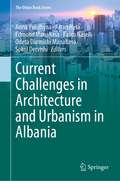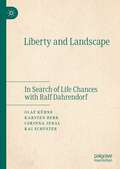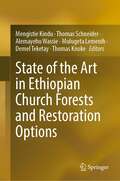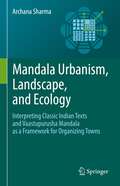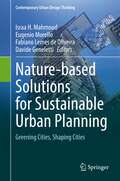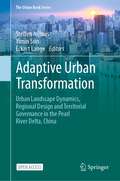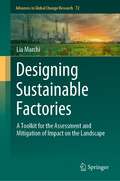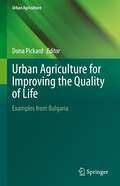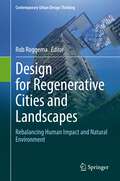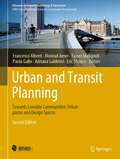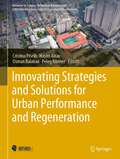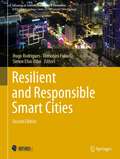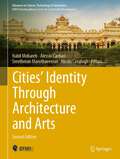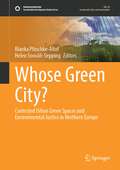- Table View
- List View
Cities’ Vocabularies: The Influences and Formations (Advances in Science, Technology & Innovation)
by Nabil Mohareb Antonella Versaci Yasser Mahgoub Sreetheran Maruthaveeran Francesco AlbertiThis book discusses several topics regarding different vocabularies, such as sacred architecture, heritage buildings, open spaces, landmarks, and street escapes, all of which have a direct influence on the city form. The city form is also affected by the indirect impact of the citizens themselves, for example their culture, which in turn depends on the arts, as can be seen and embodied in morals, paintings, media, digital art, and sculpture. The book also examines the fundamental elements that are responsible for the identity of the city. Presenting case studies that demonstrate the how implementing the concept of the responsibility of architecture and arts affects the development of our cities, the book offers a new approach that is based on the available features of a city and explores how planners and decision-makers can use these features to address the myriad problems that our cities are facing.
Suburban Retail Spaces: Formative and Transformative Process (SpringerBriefs in Geography)
by Vincenzo BuongiornoThis book derives from observations of the contemporary built environment and its contradictions. The suburban retail spaces, specifically the suburban shopping mall, and the changes caused by them within urban organisms are the object of the investigation synthesized in the volume. The topic is very crucial for the development of the contemporary city. It constitutes at the same time a problem (large commercial structures' spread is 'destroying' traditional commercial urban fabrics) and an opportunity (shopping malls are the most vital parts of the new suburbs and can play the role of community nucleus in urban and suburban areas). Furthermore, the spread of e-commerce forces these structures to functional and spatial transformations that brings also a new relationship with the city.The analytical reading, supplemented by generative and design projections, is carried out by using the conceptual and methodological tools of urban morphology, specifically those of the typological processual approach. From this specific point of view, the suburban shopping mall is read as an organism (a complex system characterized by mutual solidarity and interdependence among component elements) in itself, and as a sub-organisms belonging to the largest territorial organism.The book is intended to offer, to operators, scholars, researchers, professionals and students, a reading and design method, to interpret an important aspect of the contemporary built environment by analyzing the suburban commercial space case. It offers at the same time a model applicable to other specific not-commercial cases, to defining paths for further research and design developments.
Sustainable Land Management for NEOM Region
by Mashael M. Al SaudThis book is the first of its type on NEOM Region, NW of Saudi Arabia. This region has been designated in 2017 to be an international economic hub. However, no studies have been done on this region which occupies several natural resources including remarkable landscape with unique ecological species, ores and water resources. The region is also vulnerable to many aspects of threatening natural hazards.Based on her expertise, namely geomorphological processes, earth sciences, space techniques and natural risk assessment, the author made an initiative to produce this book using advanced tools, specifically satellite images and geo-information system. The book introduces several thematic maps obtained for the first time for NEOM Region. Hence, it represents a scientific guide for land management and urban planning approaches. This book is a very significant document for a variety of readers and researchers including decision makers, land managers and planners, as well as geographers and geologists. In addition, the basic concepts and new approaches attract researchers and academic teams including students, universities and research centers not only in Saudi Arabia, but in different parts of the World.
Resilient and Responsible Smart Cities: Volume 1 (Advances in Science, Technology & Innovation)
by Norsidah Ujang Tomohiro Fukuda Anna Laura Pisello Dinko VukadinovićThis book focuses on the ways in which resiliency can foster the transformation of cities. There is a growing need for our cities to be transformed into “smart” cities; in this regard, tremendous efforts are called for in order to face the environmental challenges that play a major role in the creation or transformation of cities and environments. This book covers a broad range of applications and approaches that are “smart” and “resilient,” which, when combined, offer much more flexibility concerning the future of our cities. Consequently, this simple combination, which is producing sweeping changes around the globe, has attracted considerable attention from scholars and decision-makers alike.
The Green Building Materials Manual: A Reference to Environmentally Sustainable Initiatives and Evaluation Methods
by Hannah Rae Roth Meghan Lewis Liane HancockEvaluating building materials for environmental sustainability is a complex prospect. How do governmental agencies and the design industry actually measure sustainable initiatives and environmental impacts? This book breaks down the technical vocabulary and principles that define environmentally sustainable choices across interior and exterior architectural products to help the reader understand: Material ingredient selectionEnergy and water useEmissions, including greenhouse gasesHuman health and toxicitySocial accountability assessment This guide explains the structure of green certifications, standards and ecolabels, life cycle assessment, environmental regulations, and more. It presents a historic timeline for context and a snapshot of current trends and future objectives. It is a comprehensive reference for interior designers, architects, building owners, contractors, and students enrolled in interior design and architecture.
Space Habitats and Habitability: Designing for Isolated and Confined Environments on Earth and in Space (Space and Society)
by Sandra Häuplik-Meusburger Sheryl BishopThis book explores creative solutions to the unique challenges inherent in crafting livable spaces in extra-terrestrial environments. The goal is to foster a constructive dialogue between the researchers and planners of future (space) habitats. The authors explore the diverse concepts of the term Habitability from the perspectives of the inhabitants as well as the planners and social sciences.The book provides an overview of the evolution and advancements of designed living spaces for manned space craft, as well as analogue research and simulation facilities in extreme environments on Earth. It highlights how various current and future concepts of Habitability have been translated into design and which ones are still missing. The main emphasis of this book is to identify the important factors that will provide for well-being in our future space environments and promote creative solutions to achieving living spaces where humans can thrive. Selected aspects are discussed from a socio-spatial professional background and possible applications are illustrated.Human factors and habitability design are important topics for all working and living spaces. For space exploration, they are vital. While human factors and certain habitability issues have been integrated into the design process of manned spacecraft, there is a crucial need to move from mere survivability to factors that support thriving. As of today, the risk of an incompatible vehicle or habitat design has already been identified by NASA as recognized key risk to human health and performance in space. Habitability and human factors will become even more important determinants for the design of future long-term and commercial space facilities as larger and more diverse groups occupy off-earth habitats. The book will not only benefit individuals and organizations responsible for manned space missions and mission simulators, but also provides relevant information to designers of terrestrial austere environments (e.g., remote operational and research facilities, hospitals, prisons, manufacturing). In addition it presents general insights on the socio-spatial relationship which is of interest to researchers of social sciences, engineers and architects.
Home - Lived Experiences: Philosophical Reflections
by John Murungi Linda ArditoThis book explores the lived experience of being at home as well as being homeless. Being at home or not is typically a matter of being at a place or not, where such a place is carved out of space and designated as such. It is a place that is both empirical and trans-empirical. When one is at home or not at home, one typically has in mind an inhabited place. To inhabit or not to inhabit it is to find oneself in a place that has an affective presence or absence. In either case, affectivity points to a lived place where lived experience is constituted and displayed. Thus, in this context, affectivity becomes more than the subject of empirical psychology. If psychology were to have access, it would be in the context of phenomenological or existential psychology – a psychology that has its roots in the sensible world and, hence, a psychology that expresses an aesthetic dimension. Each of the contributors in this book extends an invitation to the readers to participate in constituting, extending, and sharing with others the sense of either being at home or of being homeless. This book appeals to students, researchers as well as general interest readers.
Making Green Cities: Concepts, Challenges and Practice (Cities and Nature)
by Jürgen Breuste Martina Artmann Cristian Ioja Salman QureshiThis book shows what role nature can play in a city and how this can make it a better place for people to live. People, planners, designers and politicians are working towards the development of green cities. Some cities are already promoted as green cities, while others are on their way to become one. But their goals are often unclear and can include different facets. Presenting contributions from world leading researchers in the field of urban ecology, the editors provide an interdisciplinary overview of best practices and challenges in creating green cities. They show examples of how to build up these cities from bits and pieces to districts and urban extensions. Each example concludes with a summary of the collected knowledge, the learning points and how this can be used in other places. The best practices are collected from around the world – Europe, America and Asia. Contributions cover a wide range of biophysical and cultural backgrounds within these three continents, including the Central, Southern and Eastern European region, as well as Latin and North America. The new dynamic urban development of Asia is illustrated by case studies from China and the Indian subcontinent. The reader will learn which role nature can play in green cities and what the basic requirements are in terms of culture, pre-existing nature conditions, existing urban surroundings, history, design and planning.
Towards Implementation of Sustainability Concepts in Developing Countries (Advances in Science, Technology & Innovation)
by Chaham Alalouch Cristina Piselli Francesco CappaThis book focuses on sustainability concepts in architecture and urban design, environmental issues, and natural resources. Today it has become essential to reduce carbon emissions, protect habitats, and preserve the delicate ecosystems of our planet. Accordingly, sustainable development has to be improved by decreasing the consumption of non-renewable resources, in order to help nature replenish itself.Further, it highlights the efforts that have been made by architects, environmentalists, engineers, students, planners and everyone in between in order to improve sustainability in various developing communities and countries.
Metropolitan Landscapes: Towards a Shared Construction of the Resilient City of the Future (Landscape Series #28)
by Antonella ContinThis edited volume covers many aspects of the Metropolitan Landscapes. Solutions are needed to meet the demand of the citizens of a renewed metropolitan region landscape. It opens up discussions about possible toolkits for strategic actions based on understanding the territory from geographical, urban, architectural, economic, environmental, and public policy perspectives. This book intends to promote the Metropolitan dwelling quality, ensuring human well-being proposing a discussion on the resilient articulation of the interface space among the city's infrastructure, agriculture, and nature.This book results from the Symposium: Metropolitan Landscapes that MSLab of the Politecnico di Milano and ETSA (Sevilla) organized at the IALE 2019 Conference (Milan, July 2019) to manage radical territory transformation with a strategic vision. The widespread growth of urban areas indicates the importance of building resilient sustainable cities capable of minimizing climate-change impact production.The Symposium aimed to discuss the Urban Metabolism approach considering the combination of Landscapes set in a single Metropolitan Ecosystem. Accordingly, new design strategies of transformation, replacement or maintenance can compose Urban-Rural Linkage patterns and a decalage of different landscape contexts. Ecological interest in environmental sustainability, compatibility, and resilience is not tied exclusively to the balance between production and energy consumption. Thus, it is the integration over time and at several scales of the urban and rural landscapes and their inhabitants that nourish the Metropolitan Bioregion.Moreover, the Metropolitan Landscape Book's research hypothesis is the need for a Glossary, strengthening the basis of understanding Metropolitan Landscape's complexity.This book's topic is particularly relevant to Landscape Urbanism, Architecture, Urban disciplines Scholars, Students and Practitioners who want to be connected in a significant way with Metropolitan Discipline’s research field.
Urban Services to Ecosystems: Green Infrastructure Benefits from the Landscape to the Urban Scale (Future City #17)
by Chiara Catalano Maria Beatrice Andreucci Riccardo Guarino Francesca Bretzel Manfredi Leone Salvatore PastaThe aim of this book is to bring together multidisciplinary research in the field of green infrastructure design, construction and ecology. The main core of the volume is constituted by contributions dealing with green infrastructure, vegetation science, nature-based solutions and sustainable urban development. The green infrastructure and its ecosystem services, indeed, are gaining space in both political agendas and academic research. However, the attention is focused on the services that nature is giving for free to and for human health and survival. What if we start to see things from another perspective? Our actions shall converge for instance to turn man-made environment like cities from heterotrophic to autotrophic ecosystems. From landscape ecology to urban and building design, like bricks of a wall, from the small scale to the bigger landscape scale via ecological networks and corridors, we should start answering these questions: what are the services that are we offering to Nature? What are we improving? How to implement our actions? This book contains three Open Access chapters, which are licensed under the terms of the Creative Commons Attribution 4.0 International License (CC BY 4.0).
Current Challenges in Architecture and Urbanism in Albania (The Urban Book Series)
by Anna Yunitsyna Artan Hysa Edmond Manahasa Fabio Naselli Odeta Durmishi Manahasa Sokol DervishiThis book aims to provide a cross-sectorial assessment in a multidisciplinary and trans-cultural context onto the innovations in urban and architectural approaches in designing next human environments within the Albanian context. The continuous concentration of the world population in the urban areas and their consequent densification require even more quantity of quality spaces and places, integrated resources and energies, alternative modalities of mobility and transports, demand of social inclusion and need for a circular economy. These have become the major challenges for this 21st Century and some of the greatest problems facing humanity in most of current vision for the future. The main objective is to feed a debate about the emerging trans-cultural (and trans-national) approaches in the whole designing field, from Albanian context and its current good practices, attempts and faults, both formal and informal. Thus, the Albanian experience may represent an opportunity through which we all may reflect about how designing is evolving in the Mediterranean arena of “praxis and experiments” aimed to a better quality of life at the human scale and in expanding the concepts of “place and space” such as it has improved by the effects in designing innovations.This book represents a useful read of theories, experiences and case studies, which can help in enlarging reflection on how the designing practice is evolving in the arena of forthcoming development strategies and tactics, all addressed to improve the quality of life, places and spaces. Additionally, it provides a range of architecture and urban design rationales and strategies for reinforcing identities and creating memorable places within the quality of contemporary architecture and urbanism. It addresses the unique needs of architects and planners to deal with topics that cut across social, economic and environmental issues and shows readers how to explore methods, theoretical frameworks and techniques to address the complex needs of architecture, urban and cultural development.
Liberty and Landscape: In Search of Life Chances with Ralf Dahrendorf
by Olaf Kühne Karsten Berr Corinna Jenal Kai SchusterThis book explores the importance of freedom and liberalism in the context of socialities, individualities and materialities. The authors provide a highly unusual and innovative blending of concepts about space and landscape through a deeply theoretical exploration of liberalism.Liberalism is often problematized in contemporary discussions with regard to gentrification, environmental problems and inequality. In contrast, this book refers to a liberalism that maximizes life chances in the context of dealing with spaces. A connection between freedom and space, based on liberal ideas, provides a much needed theoretical intervention in the fields of social and spatial sciences.
State of the Art in Ethiopian Church Forests and Restoration Options
by Thomas Schneider Demel Teketay Mengistie Kindu Alemayehu Wassie Mulugeta Lemenih Thomas KnokeThis book, with contributions from leading academics - and including reviews and case studies from Ethiopian Church forests - provides a valuable reference for advanced students and researchers interested in forest and other natural resource management, ecology and ecosystem services as well as restoration options. The book addresses various aspects including a general overview of Ethiopian church forests, the present role and future challenges of church forests. It also discusses their structure and diversity in the context of sustainability and discusses restoration options for surrounding landscapes, under consideration of the circumstances of the land and the needs of surrounding communities. The intended readership includes natural resource professionals in general as well as forestry professionals in particular (practitioners, policymakers, educators and researchers). The book will provide the reader with a good foundation for understanding Ethiopian forest resources and restoration options of degraded landscape.
Mandala Urbanism, Landscape, and Ecology: Interpreting classic Indian texts and Vaastupurusha mandala as a framework for organizing towns
by Archana SharmaClassic Indian texts and Vaastupurusha Mandala are not often discussed in the western discourse on urbanism, even while much of these predate the commonly taught European writings. This book sheds light on some of those forgotten concepts, thus making the lesser discussed classic Indian town organization ideas accessible to architecture, landscape, and urban planning students worldwide. The resonance of these concepts in present times are reviewed through case studies of select Hindu temple towns in India. Furthermore, the author underscores the formal abstraction of the classic Indian Mandala and transplants the discourse from sociology to socio-ecologically adept trans-disciplinary design thinking. The creative interpretations offer a premise to start revising classic models for current practice to influence the urbanism and ecology of a place in accordance with the changing climate.
Nature-based Solutions for Sustainable Urban Planning: Greening Cities, Shaping Cities (Contemporary Urban Design Thinking)
by Israa H. Mahmoud Eugenio Morello Fabiano Lemes de Oliveira Davide GenelettiUrban greening policies and measures have recently shown a high potential impact on the design and reshaping of the built environment, especially in urban regeneration processes. This book provides insights on analytical methods, planning strategies and shared governance tools for successfully integrating Nature-Based Solutions (NBS) in the urban planning practice. The selected contributions present real-life application cases, in which the mainstreaming of NBS are investigated according to two main challenges: the planning and designing of physical and spatial integration of NBS in cities on one side, and the implementation of suitable shared governance models and co-creation pathways on the other. Chapter 5 is available open access under a Creative Commons Attribution 4.0 International License via link.springer.com.
Adaptive Urban Transformation: Urban Landscape Dynamics, Regional Design and Territorial Governance in the Pearl River Delta, China (The Urban Book Series)
by Steffen Nijhuis Yimin Sun Eckart LangeThis open access book provides a cross-sectoral, integrative and multi-scale design and planning approach for adaptive urban transformation of fast urbanising deltas, taking the Pearl River Delta (China) as a case study. Deltaic areas are among the most promising regions in the world. Their strategic location and superior quality of their soils are core factors supporting both human development and the rise of these regions as global economic hubs. At the same time, however, deltas are extremely vulnerable to multiple threats from both climate change and urbanisation. These include an increased flood risk combined with the resulting loss of ecological and social-cultural values. To ensure a more sustainable future for these areas, spatial strategies are needed to strengthen resilience, i.e. help the systems to cope with their vulnerabilities as well as enhance their capacity to overcome natural and artificial threats.The book provides a unique approach that integrates research in urban landscape systems, territorial governance and visualisation techniques that will help to achieve more integrated and resilient deltas. Based on an assessment of the dynamics of change regarding the transformational cycles of natural and urban landscape elements, eco-dynamic regional design strategies are explored to reveal greater opportunities for the exploitation of natural and social-cultural factors within the processes of urban development.
Designing Sustainable Factories: A Toolkit for the Assessment and Mitigation of Impact on the Landscape (Advances in Global Change Research #72)
by Lia MarchiEconomic constraints and lack of knowledge often prevent companies - especially small and medium enterprises - from harmonizing their facilities with the landscape. As a result, factories significantly impact the quality of our living environment, in terms of physical effects on the ecosystem, perceptual interferences with the surroundings, and disturbances on local communities. At both the design and maintenance stages, a set of appropriate tools can assist businesses in becoming more aware of their impacts and identifying possible mitigation strategies. The book presents an assessment tool and a library of inspiring design tactics for factories, with examples of the benefits and synergies for the environment, the scenery, the community, and the company itself. The purpose is to elicit more than a simple reflection about what a sustainable factory entails. It is rather to encourage and assist both businesses and designers in mitigating the impact of industrial facilities on the landscape as holistically as possible.
Urban Agriculture for Improving the Quality of Life: Examples from Bulgaria (Urban Agriculture)
by Dona PickardThis book presents the findings of a multidisciplinary study on the effects of urban agriculture (UA) on the social, economic and environmental aspects of the quality of life in Sofia - the capital of Bulgaria. The analyses are based on a sociological survey representative of 3 districts of Sofia (among 750 people), in-depth interviews, focus groups, expert statements, ecological monitoring of UA sites, and spatial mapping of natural resources for UA. It also focuses on UA effects on the social well-being of citizens and communities, the correlation between social capital and UA attitudes, the challenges for UA to integrate disadvantaged social groups, the factors for success of small UA businesses, as well as the role of policy and civil society in developing UA. This work is also important for the analysis of the underlying links between all aspects of urban agriculture, many of which are valid beyond the local socio-economic context and environmental specifics of the city of Sofia.
Design for Regenerative Cities and Landscapes: Rebalancing Human Impact and Natural Environment (Contemporary Urban Design Thinking)
by Rob RoggemaThis book discusses the way to design and plan for regenerative cities and landscapes. Where sustainability aims to safeguard the resources for future generations, and the resilience concept focuses on dealing with shocks to keep the system functioning, regeneration aims to give back more than it takes from the system. This principle is often used in analytical and assessment literature, but not yet elaborated in a spatial planning and design context, which this book does. It offers insights from a range of perspectives, spatial scales, such as the country level, neighbourhood public space, streets and the building levels, scientific fields and continents, amongst which Africa, Oceania, and Europe.
Urban and Transit Planning: Towards Liveable Communities: Urban places and Design Spaces (Advances in Science, Technology & Innovation)
by Francesco Alberti Mourad Amer Yasser Mahgoub Paola Gallo Adriana Galderisi Eric StraussThis book incorporates a wealth of research focused on the more and more urgent challenges that urban planning and architectural design all over the world must cope with: from climate change to environmental decay, from an increasing urban population to an increasing poverty. In detail, this book aims at providing innovative approaches, tool and case study examples that, in line with the agenda of 2030, may better drive human settlements toward a sustainable, inclusive and resilient development. To this aim, the book includes heterogeneous regional perspectives and different methodologies and suggests development models capable of limiting further urban growth and re-shaping existing cities to improve both environmental quality and the overall quality of life of people, also taking account the more and more close relationships among urban planning and technological innovation.
Innovating Strategies and Solutions for Urban Performance and Regeneration (Advances in Science, Technology & Innovation)
by Cristina Piselli Haşim Altan Osman Balaban Peleg KremerThis book focuses on enhancing urban regeneration performance and strategies that pave the way toward sustainable urban development models and solutions. The book at hand thoroughly examines the latest studies on the regeneration of urban areas and attempts at alleviating the negative impacts associated with high population density and urban heat effects. It gathers contributions that combine theoretical reflections and international case studies on urban regeneration and transformation with the single goal of tackling existing social and economic imbalances and developing new solutions. The primary audience of this book will be from the field of architecture and urban planning, offering new insights on how to address the myriad of problems that our cities are facing.
Resilient and Responsible Smart Cities (Advances in Science, Technology & Innovation)
by Hugo Rodrigues Tomohiro Fukuda Simon Elias BibriThis book gathers current research studies which explore new technologies in architecture and urban practices which ensure the efficient management of cities’ infrastructures and provide new solutions to the complex complications that may result in the tackling of challenges of population density, traffic planning, and city planning at the neighborhood scale or rather the scale of buildings and everyday life. It offers a path towards city resilience and sustainable infrastructure with the aim of meeting the demands of mega-cities. The primary audience of this book will be academics and professionals from the fields of architecture, urban planning, civil engineering, computer sciences, and mathematics. The book will aid them in their contributions to the implementation of sustainable development goals.
Cities’ Identity Through Architecture and Arts (Advances in Science, Technology & Innovation)
by Nabil Mohareb Alessio Cardaci Sreetheran Maruthaveeran Nicola CavalagliThis book presents works that book offer a novel interpretation of how today's urban problems can be tackled through the efficient use of resources and the modeling of solutions to best utilize the available features of cities. The second edition of this book compiles several research papers that present a detailed discussion of the formation and identification of cities and illustrate different case studies that deal with historical areas and buildings as part of preserving cities' vocabularies and self-identities. By unfolding a stimulating variety of topics in relation to the conservation of culture and identity, the book provides insights into planners and decision-makers, aiding them in their contributions to the implementation of the 2030 Sustainable Development goals with reference to heritage preservation.
Whose Green City?: Contested Urban Green Spaces and Environmental Justice in Northern Europe (Sustainable Development Goals Series)
by Bianka Plüschke-Altof Helen Sooväli-SeppingAgainst the backdrop of an accelerating global urbanization and related ecological, climatic or social challenges to urban sustainability, this book focuses on the access to “safe, inclusive and accessible green and public space” as outlined in United Nations’ Sustainable Development Goal No. 11. Looking through the lens of environmental justice and contested urban spaces, it raises the question who ultimately benefits from a green city development, and – even more importantly – who does not. While green space benefits are well-documented, green space provision is faced by multiple challenges in an era of urban neoliberalism. With their interdisciplinary and multi-method approach, the chapters in this book carefully study the different dimensions of green space access with particular focus on vulnerable groups, critically evaluate cases of procedural injustice and, in the case of Northern Europe that is often seen as forerunner of urban sustainability, provide in-depth studies on the contexts of injustices in urban greening. Chapters 1, 5, and 6 are available open access under a Creative Commons Attribution 4.0 International License via link.springer.com.
